In addition to taming wild animals in ARK: Survival Evolved, players can also hatch eggs to hatch many creatures. This can be a long process that requires a lot of investment, but this article will help anyone become an egg incubation expert.
In this guide, players will be provided with all the information about the process of collecting and hatching eggs in ARK: Survival Evolved to enrich their animal collection.
Download ARK: Survival Evolved for Android Download ARK: Survival Evolved for iOS
Table of contents
- How to collect eggs in ARK: Survival Evolved
- How to hatch eggs in ARK: Survival Evolved
- Incubation conditions
- Things to keep in mind when incubating eggs
How to collect eggs in ARK: Survival Evolved
Before trying to get an egg, it's important to know where the egg comes from. Not all organisms lay eggs, they only come from non-mammal organisms. A list of non-mammal creatures in the game will be mentioned later in the article. Additionally, only fertilized eggs can be incubated.

Obtain eggs from tamed creatures
To get a fertilized egg, the player will need to breed 2 creatures. Breeding requires two organisms of the same species of different sexes with the following requirements:
- The two creatures need to be close to each other.
- Enable feature: Wandering and Mating: Make sure the creature in question has not mated recently as this will require a waiting period.
- Creatures cannot currently follow anything (including players).
- The storage space should not be too full.
- Creatures cannot be mounted.
- Creatures cannot be destroyed or disabled.
When all these conditions are met, the organisms can mate. This will make red hearts appear above both of their heads and they will begin the process. When the process is complete, the female will release an egg for the player to pick up. The process will immediately end if the pair is separated.
Can eggs be obtained from wild creatures?
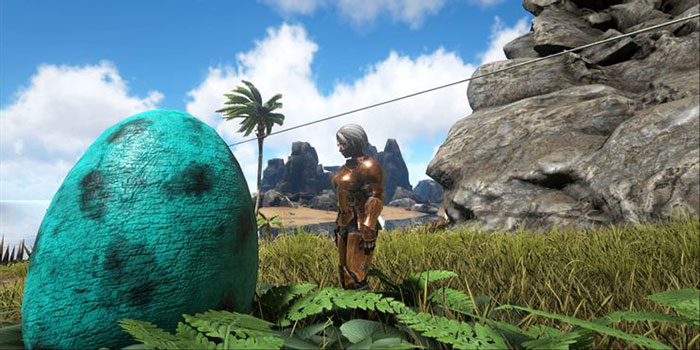
Note that wild creatures also release an egg on the ground but it will not be able to be incubated because this egg is not fertilized.
How to hatch eggs in ARK: Survival Evolved
To incubate eggs, gamers need to keep it in an area with a stable temperature. Maintaining a stable temperature can be done in a number of ways:
Campfire and torches
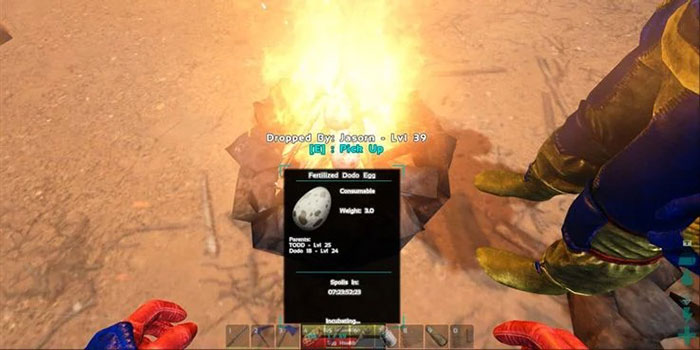
This is a very simple way to maintain temperature, but it is also quite difficult. Campfires radiate a fair amount of heat, however, there are external factors that can change the overall temperature. When dealing with “difficult” eggs, players should use a campfire to incubate them. If you use this method for incubation, be sure to monitor the egg closely.
Air conditioner
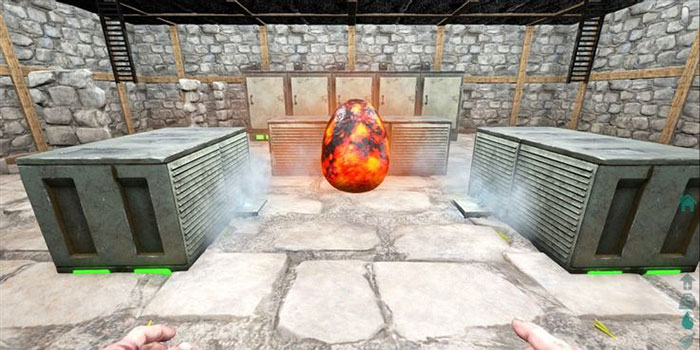
With eggs hatching at low temperatures, people can use air conditioners to reduce the temperature in the room. An air conditioner will be available for 21 engram points when the player becomes level 61. Additionally, it will require the following ingredients to craft this item:
- 80 Metal Ingot
- 15 Electronics
- 5 Polymers
- 15 Crystals
Hatcher
Incubators are available in the Genesis: Part 2 DLC. With the egg incubator, players can place up to 10 eggs inside and choose the desired temperature. This device will be available for 55 engram points when the gamer reaches level 89. Below are the materials needed to craft the incubator.
- 500 Metal ingot
- 350 Polymers
- 200 Crustals
- 100 Cementing Paste (or Achatina Paste)
- 250 Electronics
This is the best way to incubate eggs, but if you don't have the Genesis: Part 2 DLC, you can still incubate them using the air conditioning method.
Incubation conditions
Each egg will require a different time and temperature when incubating. The table below will provide complete information about incubation time and ideal temperature for all types of eggs in ARK: Survival Evolved.
| Egg type | Incubation time | Lowest incubation temperature | Highest incubation temperature |
| Allosaurus | 1 hour 39 minutes | 79 | 90 |
| Anglerfish | 4 hours 59 minutes | -103 | 167 |
| Ankylosaurus | 2 hours 37 minutes | sixty one | 68 |
| Araneo | 1 hour 25 minutes | 39 | 54 |
| Archeopteryx | 2 hours 37 minutes | sixty one | 68 |
| Argentavis | 2 hours 56 minutes | 54 | 56 |
| Arthropluera | 2 hours 29 minutes | sixty four | 72 |
| Baryonyx | 1 hour 59 minutes | 84 | 95 |
| Beelzebufo | 4 hours 59 minutes | 32 | 122 |
| Bloodstalker | 2 hours 56 minutes | 81 | eighty six |
| Carbonemys | 1 hour 14 minutes | eighty six | 93 |
| Carnotaurus | 1 hour 39 minutes | 79 | 90 |
| Compy | 49 minutes | 75 | 90 |
| Crystal Wyvern | 4 hours 59 minutes | 167 | 185 |
| Deinonychus | 4 hours 59 minutes | 176 | 194 |
| Dilophosaur | 1 hour 8 minutes | 82 | 90 |
| Dimetrodon | 2 hours 29 minutes | eighty six | 93 |
| Dimorphodon | 1 hour 21 minutes | 95 | 100 |
| Diplocaulus | 4 hours 59 minutes | 32 | 122 |
| Diplodocus | 4 hours 59 minutes | 79 | 84 |
| Dodo | 49 minutes | 72 | eighty six |
| Electrophorus | 4 hours 59 minutes | 32 | 122 |
| Featherlight | 1 hour 39 minutes | 84 | 90 |
| Gallimimus | 1 hour 25 minutes | 75 | 82 |
| Giganotosaurus | 2 hours 56 minutes | 109 | 111 |
| Glowtail | 2 hours 29 minutes | eighty six | 93 |
| Hesperornis | 1 hour 30 minutes | 72 | eighty six |
| Ichthyornis | 1 hour 39 minutes | 84 | 90 |
| Iguanodon | 1 hour 25 minutes | 75 | 82 |
| Kairuku | 1 hour 30 minutes | 72 | eighty six |
| Kaprosuchus | 1 hour 59 minutes | 84 | 95 |
| Kentrosuarus | 2 hours 46 minutes | 75 | eighty six |
| Lymantria | 1 hour 30 minutes | 95 | 100 |
| Lystrosaurus | 49 minutes | 75 | 82 |
| Maewing | 1 hour 25 minutes | 72 | 79 |
| Magmasaur | 4 hours 59 minutes | 194 | 230 |
| Mantis | 2 hours 46 minutes | 95 | 100 |
| Megachelon | 4 hours 59 minutes | -103 | 167 |
| Megalosaurus | 2 hours 39 minutes | 79 | 90 |
| Microraptor | 1 hour 25 minutes | 75 | 82 |
| Morellatops | 2 hours 29 minutes | 72 | 82 |
| Moschops | 2 hours 37 minutes | sixty one | 68 |
| Oviraptor | 1 hour 8 minutes | 79 | eighty six |
| Pachy | 1 hour 25 minutes | 75 | 82 |
| Pachyrhinosaurus | 2 hours 29 minutes | 72 | 82 |
| Parasaur | 1 hour 25 minutes | 75 | 82 |
| Pegomastax | 1 hour 8 minutes | 82 | 90 |
| Pelagornis | 1 hour 39 minutes | 84 | 90 |
| Pteranodon | 1 hour 39 minutes | 84 | 90 |
| Pulmonoscorpius | 1 hour 59 minutes | 54 | sixty one |
| Quetzal | 16 hours 39 minutes | 41 | 43 |
| Raptor | 1 hour 59 minutes | 68 | 82 |
| T-Rex | 4 hours 59 minutes | 90 | 93 |
| Rock Drake | 6 hours 14 minutes | -130 | -112 |
| Sarco | 2 hours 29 minutes | eighty six | 93 |
| Snow Owl | 2 hours 56 minutes | 54 | 56 |
| Spino | 2 hours 50 minutes | eighty six | 90 |
| Stegosaurus | 2 hours 46 minutes | 72 | 82 |
| Tapejara | 1 hour 39 minutes | 84 | 90 |
| Terror Bird | 1 hour 59 minutes | 68 | 82 |
| Therizinosaur | 1 hour 39 minutes | 79 | 90 |
| Thorny Dragon | 2 hours 29 minutes | 72 | 82 |
| Triceratops | 2 hours 29 minutes | 72 | 82 |
| Troodon | 1 hour 8 minutes | 82 | 90 |
| Tropeognathus | 1 hour 39 minutes | 84 | 90 |
| Tusoteuthis | 4 hours 59 minutes | 32 | 122 |
| Velonasaur | 1 hour 8 minutes | 82 | 90 |
| Voidwyrm | 4 hours 59 minutes | 176 | 194 |
| Vulture | 1 hour 21 minutes | 95 | 100 |
| Wyvern | 4 hours 59 minutes | 176 | 194 |
| Yutryannus | 4 hours 59 minutes | 90 | 93 |
Things to keep in mind when incubating eggs
Pay close attention to the temperature ranges
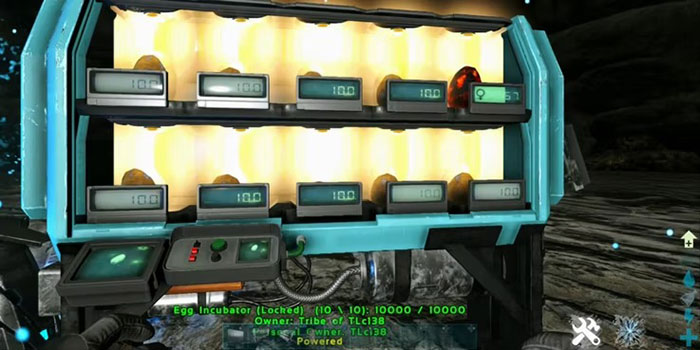
Incubating eggs in ARK: Survival Evolved requires temperatures ranging from near-freezing to super hot. Additionally, many egg types have very narrow temperature gradients that need to be considered.
For example, a Yutryannus egg allows a difference of 3 degrees. This means that using a campfire to incubate this egg is not the best idea; If it becomes cold outside, the egg temperature may drop and the eggs will not hatch.
Check current temperature
Players can check the current air temperature from their inventory, which displays character statistics. On the right side of this panel, people will see the current temperature, displayed in Celsius or Fahrenheit (the temperature measurement unit can be changed from the settings menu).
Temperature variation on an island
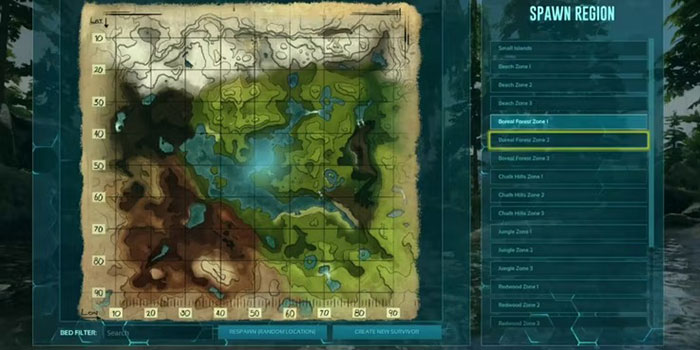
Temperatures may vary between areas on the map, but for the most part, temperatures will remain average. For example, the southern end of the island will be hotter than any other area. Keep this in mind if you choose to incubate your eggs outdoors.
Prioritize the use of air conditioning
In general, gamers should prioritize equipping an incubator or air conditioner for eggs that require precise temperatures. If they do not have access to these items, the player can create an enclosed area with torches to place the egg inside. This will only incubate eggs that require higher temperatures.
